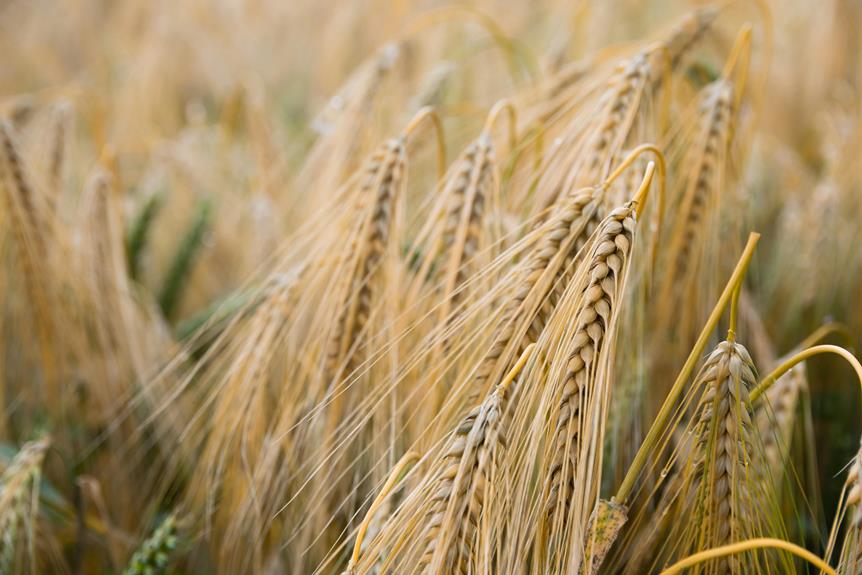Did you know that nearly 67% of AeroGarden owners are curious about using their own seeds instead of pre-packaged seed pods? You're likely wondering whether you can start on this gardening adventure too. By selecting the right seeds and adequately preparing them, you can transform your AeroGarden into a custom nursery. The process involves a few key steps that guarantee your seeds thrive in the hydroponic environment. Let's explore how you can begin this journey, considering the best practices for seed selection and preparation that could lead to lush, bountiful growth. What might you discover by trying a variety of seeds?
Key Takeaways
- You can grow your own seeds in an AeroGarden by using custom seed pods.
- Select seeds that thrive in hydroponic environments for optimal results.
- Ensure seeds are pre-soaked and planted at recommended depths for better germination.
- Maintain the water pH between 5.5 and 6.5 for healthy plant growth.
- Regularly monitor and adjust nutrient levels to support the development of your plants.
Understanding the AeroGarden System
Before you plant your first seed, it's important to grasp how the AeroGarden system functions. This hydroponic unit isn't just any garden; it's a controlled environment designed to maximize plant growth. You're in charge, manipulating conditions to suit your specific plant varieties.
Your AeroGarden uses a water-based solution instead of soil, circulating nutrient-rich water directly to the roots. This system guarantees your plants get exactly what they need when they need it, without the guesswork typically involved in traditional gardening. You'll monitor and adjust the pH levels and nutrient concentrations, tailoring the environment to promote robust growth.
Lighting is automated but adjustable. The LED lights mimic natural sunlight, encouraging photosynthesis. However, you can tweak the settings, controlling the intensity and duration of light each day. This enables you to replicate the ideal growing conditions regardless of the season.
Understanding the mechanics behind your AeroGarden empowers you to take full command. Each variable is at your fingertips, allowing you to cultivate your garden with precision.
Benefits of Using Your Own Seeds
Using your own seeds in the AeroGarden not only cuts costs but also allows you greater control over the variety and quality of plants you grow. You're not limited to the seed kits that are marketed directly for use in AeroGardens, which opens up a whole new world of gardening possibilities right in your own home. This autonomy lets you tailor your indoor garden to meet your specific preferences and needs.
Here are some compelling reasons to start using your own seeds:
- Personalization: Choose from a wider variety of plants that aren't available in pre-packaged seed kits.
- Cost-effectiveness: Reduce your expenses by purchasing bulk seeds or using leftovers from your outdoor garden.
- Quality control: Select seeds based on their organic status or non-GMO properties, ensuring you know exactly what you're growing.
- Experimentation: Enjoy the freedom to experiment with unusual or exotic plants that can be difficult to find in stores.
Selecting the Right Seeds
Now that you're ready to use your own seeds, it's crucial to know how to select the best ones for your AeroGarden.
First, you'll need to decide what you want to grow. Consider plants that thrive in a hydroponic environment, such as herbs, lettuce, and cherry tomatoes. It's important to choose varieties that don't require pollination or can be easily hand-pollinated.
You must also look for high-quality seeds. Opt for reputable brands known for their germination success; this ensures you're not wasting your time or resources on seeds that won't sprout.
Check the seed packet for the harvest cycle information. Shorter cycles are generally better suited to the continuous production potential of an AeroGarden.
Additionally, you want to make sure that the seeds you select are appropriate for the size of your AeroGarden. Avoid large plants that require more space than your setup can provide. Compact or dwarf varieties often work best.
Preparing Your Seeds for Planting
Prepare your seeds for the AeroGarden by pre-soaking them to enhance germination rates. This simple step can greatly improve the odds of your seeds sprouting successfully, giving you more control over your gardening outcomes.
Here's a quick guide on how to get your seeds ready:
- Select the Right Container: Use a small bowl or cup filled with warm water. Make sure it's clean to prevent any contamination that could impact seed quality.
- Monitor Soaking Time: Different seeds require different soaking times. Generally, soak for 12 to 24 hours. Over-soaking can harm seeds, so keep an eye on the clock.
- Water Temperature: Use room-temperature water to avoid shocking the seeds. Extreme temperatures can impede the germination process.
- Drain and Dry: After soaking, drain the seeds and gently pat them dry with a clean paper towel. This prevents fungal growth, which could destroy the seeds before they even get a chance to grow.
Once your seeds are prepped, you'll be ready to place them in your AeroGarden pods. With these steps, you're taking proactive measures to make sure your gardening venture is as successful and satisfying as possible.
Custom Seed Pod Alternatives
After preparing your seeds, consider creating custom seed pods as a cost-effective and personalized alternative to pre-packaged options. By customizing your pods, you're taking control of your gardening experience, ensuring that you're planting exactly what you desire.
You'll first need a few basic materials: lightweight grow media like peat moss or coco coir, small plastic cups or recycled pod casings, and labels for organization.
Start by filling your chosen containers with the grow media, compacting it slightly to mimic the density of commercial pods. Next, plant your seeds at the recommended depth, generally a couple of millimeters below the surface. It's critical to keep them evenly spaced to avoid overcrowding, which can hinder growth.
Setting Up Your AeroGarden
Once you've assembled your AeroGarden, make sure it's placed in a location that receives plenty of indirect light. This will help guarantee that your plants get the ideal conditions they need without being damaged by harsh direct sunlight.
It's also important to take into account the surrounding environment; keeping your AeroGarden away from drafty windows or heating vents can prevent sudden temperature fluctuations that might stress your plants.
Here are a few key steps to optimize the setup of your AeroGarden:
- Choose the Right Location: Find a spot that maintains a consistent temperature and is free of direct sunlight.
- Maintain Proper Water Levels: Always keep the water reservoir filled to the appropriate line to avoid underwatering or overwatering.
- Add Nutrients Thoughtfully: Follow the nutrient schedule that comes with your AeroGarden to provide your plants with the right amount of feed.
- Adjust the Light Hood: As your plants grow, raise the light hood to give them enough space without burning the foliage.
Monitoring Plant Growth
Now that your AeroGarden is set up, it's important to regularly monitor your plants' growth to make certain they thrive. Keeping a close eye on your plants allows you to quickly address any issues and optimize conditions for healthy development.
To effectively track growth, you'll need to observe several key indicators. Here's a handy table to help you keep track:
| Growth Indicator | What to Look For |
|---|---|
| Height | Consistent increase in stem length |
| Leaf Color | Bright, even coloring without spots |
| Root Appearance | White or cream-colored, firm roots |
| New Growth | Regular emergence of new leaves/flowers |
| General Vigor | Strong, upright posture and resilience |
Managing Water and Nutrients
Proper management of water and nutrients is crucial for the health of your AeroGarden plants. To guarantee your seeds develop into thriving plants, you'll need to take control of their growing environment. This means regularly checking and adjusting the water levels and nutrient concentrations.
Here's what you should focus on to maintain ideal conditions:
- Check Water Levels Daily: Make sure the water level meets the recommended guidelines for your specific AeroGarden model. Too little or too much can hinder plant growth.
- Maintain Nutrient Balance: Follow the feeding schedule that comes with your AeroGarden. Over or under-fertilizing can lead to poor plant health or even damage.
- Adjust pH Levels: Keep the water pH between 5.5 and 6.5 for optimal nutrient uptake. Use pH adjusters if necessary.
- Monitor Water Quality: Replace the water every 4-6 weeks to prevent the buildup of harmful salts and minerals.
Troubleshooting Common Issues
If you notice your plants looking unhealthy, several common issues might be at play. First, check if your Aerogarden's light is functioning properly. Insufficient light can stunt growth, making your plants appear weak or discolored. You'll want to make sure that the light hood is positioned correctly—close enough to provide adequate light but not so close that it scorches your plants.
Next, examine the roots. If they're brown and slimy, root rot could be the culprit. This usually happens when there's too much water and not enough oxygen. You can combat this by adjusting the water levels and ensuring the pump is working correctly to circulate air and water effectively.
Don't overlook the importance of cleaning your Aerogarden regularly. Build-up of salts and minerals can interfere with nutrient uptake. Clean your system every few weeks using non-abrasive cleaners and rinse thoroughly to prevent any chemical residues which could harm your plants.
Lastly, pests can sometimes invade, even in an indoor setting like the Aerogarden. Look closely for signs of insects or disease. If pests are present, you might need to apply an appropriate insecticide or adjust the environmental conditions to make them less hospitable for invaders.
Harvesting Your Plants
Once you've addressed any issues with plant health and maintenance, you're ready to start harvesting the fruits of your labor from the Aerogarden. It's time to reap what you've sown, and with a bit of know-how, you'll maximize your yield and enjoy the freshest produce right from your own home.
Here are some key pointers to guarantee a successful harvesting:
- Monitor Growth Closely: Keep an eye on your plants. Harvest when they're at peak freshness. This not only guarantees excellent flavor but also encourages further growth.
- Use the Right Tools: Sharp scissors or pruning shears can help you cut cleanly without damaging the plant.
- Harvest Regularly: Regular harvesting stimulates growth and increases overall yield.
- Understand Each Plant's Needs: Different plants have unique harvesting times and methods. Make sure you're familiar with each.
You'll find that the control you have over the timing and method of harvest directly impacts the quality of your produce. Don't hesitate to experiment with different harvesting times to see what works best for your plants. This hands-on approach not only enhances your gardening skills but also leads to a more satisfying Aerogarden experience.




Konnichiwa! (Hello!) I'm Pat Tokuyama, a Japanese tofu cookbook author, who travels for music, food, and adventure. If you like Japanese tea, checkout some of the newestorganic japanese tea, matcha bowls and noren and more!
** Curious about the Plant Based Japanese Cooking Club? ** Learn more here!